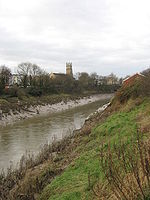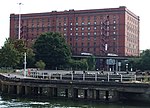Clifton Bridge railway station

Clifton Bridge railway station is a former railway station in the Bower Ashton district of Bristol, England, near the River Avon. It was opened in 1867 by the Bristol and Portishead Pier and Railway Company as a single platform stop 3.4 miles (5.5 km) along the line from Bristol to Portishead. It was later taken over by the Great Western Railway and had a second platform added. Passenger services at the station declined following the Second World War, and the Beeching Report recommended the complete closure of the Portishead line. Passenger services at Clifton Bridge ended on 7 September 1964, with goods services following on 5 July 1965, although the line saw occasional traffic until 1981. Most of the station was demolished, leaving some remains of the platforms, a retaining wall and the footbridge. Regular freight trains through the station began to run again in 2002 when Royal Portbury Dock was connected to the rail network. The line is due to be reopened to passenger traffic as part of MetroWest, but there are no plans to reopen the station.
Excerpt from the Wikipedia article Clifton Bridge railway station (License: CC BY-SA 3.0, Authors, Images).Clifton Bridge railway station
Brunel Way, Bristol Hotwells
Geographical coordinates (GPS) Address Nearby Places Show on map
Geographical coordinates (GPS)
| Latitude | Longitude |
|---|---|
| N 51.44677 ° | E -2.62573 ° |
Address
River Avon Trail
Brunel Way
BS1 6XS Bristol, Hotwells
England, United Kingdom
Open on Google Maps









